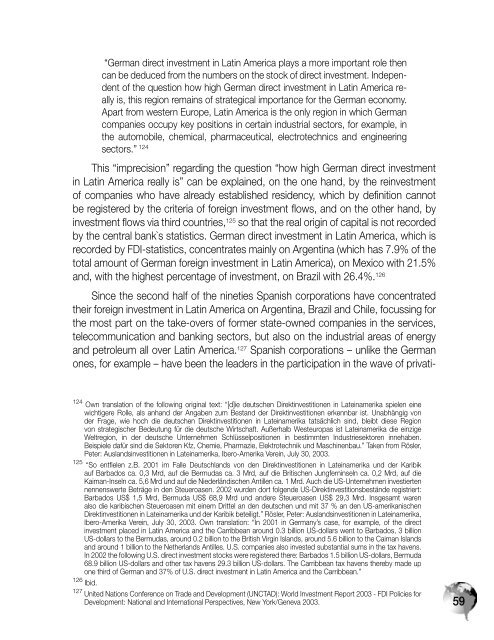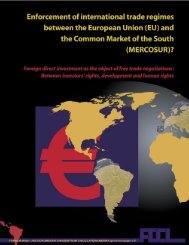Download - FDCL
Download - FDCL
Download - FDCL
You also want an ePaper? Increase the reach of your titles
YUMPU automatically turns print PDFs into web optimized ePapers that Google loves.
“German direct investment in Latin America plays a more important role then<br />
can be deduced from the numbers on the stock of direct investment. Independent<br />
of the question how high German direct investment in Latin America really<br />
is, this region remains of strategical importance for the German economy.<br />
Apart from western Europe, Latin America is the only region in which German<br />
companies occupy key positions in certain industrial sectors, for example, in<br />
the automobile, chemical, pharmaceutical, electrotechnics and engineering<br />
sectors.” 124<br />
This “imprecision” regarding the question “how high German direct investment<br />
in Latin America really is” can be explained, on the one hand, by the reinvestment<br />
of companies who have already established residency, which by definition cannot<br />
be registered by the criteria of foreign investment flows, and on the other hand, by<br />
investment flows via third countries, 125 so that the real origin of capital is not recorded<br />
by the central bank`s statistics. German direct investment in Latin America, which is<br />
recorded by FDI-statistics, concentrates mainly on Argentina (which has 7.9% of the<br />
total amount of German foreign investment in Latin America), on Mexico with 21.5%<br />
and, with the highest percentage of investment, on Brazil with 26.4%. 126<br />
Since the second half of the nineties Spanish corporations have concentrated<br />
their foreign investment in Latin America on Argentina, Brazil and Chile, focussing for<br />
the most part on the take-overs of former state-owned companies in the services,<br />
telecommunication and banking sectors, but also on the industrial areas of energy<br />
and petroleum all over Latin America. 127 Spanish corporations – unlike the German<br />
ones, for example – have been the leaders in the participation in the wave of privati-<br />
124 Own translation of the following original text: “[d]ie deutschen Direktinvestitionen in Lateinamerika spielen eine<br />
wichtigere Rolle, als anhand der Angaben zum Bestand der Direktinvestitionen erkennbar ist. Unabhängig von<br />
der Frage, wie hoch die deutschen Direktinvestitionen in Lateinamerika tatsächlich sind, bleibt diese Region<br />
von strategischer Bedeutung für die deutsche Wirtschaft. Außerhalb Westeuropas ist Lateinamerika die einzige<br />
Weltregion, in der deutsche Unternehmen Schlüsselpositionen in bestimmten Industriesektoren innehaben.<br />
Beispiele dafür sind die Sektoren Kfz, Chemie, Pharmazie, Elektrotechnik und Maschinenbau.” Taken from Rösler,<br />
Peter: Auslandsinvestitionen in Lateinamerika, Ibero-Amerika Verein, July 30, 2003.<br />
125 “So entfielen z.B. 2001 im Falle Deutschlands von den Direktinvestitionen in Lateinamerika und der Karibik<br />
auf Barbados ca. 0,3 Mrd, auf die Bermudas ca. 3 Mrd, auf die Britischen Jungferninseln ca. 0,2 Mrd, auf die<br />
Kaiman-Inseln ca. 5,6 Mrd und auf die Niederländischen Antillen ca. 1 Mrd. Auch die US-Unternehmen investierten<br />
nennenswerte Beträge in den Steueroasen. 2002 wurden dort folgende US-Direktinvestitionsbestände registriert:<br />
Barbados US$ 1,5 Mrd, Bermuda US$ 68,9 Mrd und andere Steueroasen US$ 29,3 Mrd. Insgesamt waren<br />
also die karibischen Steueroasen mit einem Drittel an den deutschen und mit 37 % an den US-amerikanischen<br />
Direktinvestitionen in Lateinamerika und der Karibik beteiligt.” Rösler, Peter: Auslandsinvestitionen in Lateinamerika,<br />
Ibero-Amerika Verein, July 30, 2003. Own translation: “In 2001 in Germany’s case, for example, of the direct<br />
investment placed in Latin America and the Carribbean around 0.3 billion US-dollars went to Barbados, 3 billion<br />
US-dollars to the Bermudas, around 0.2 billion to the British Virgin Islands, around 5.6 billion to the Caiman Islands<br />
and around 1 billion to the Netherlands Antilles. U.S. companies also invested substantial sums in the tax havens.<br />
In 2002 the following U.S. direct investment stocks were registered there: Barbados 1.5 billion US-dollars, Bermuda<br />
68.9 billion US-dollars and other tax havens 29.3 billion US-dollars. The Carribbean tax havens thereby made up<br />
one third of German and 37% of U.S. direct investment in Latin America and the Carribbean.”<br />
126 Ibid.<br />
127 United Nations Conference on Trade and Development (UNCTAD): World Investment Report 2003 - FDI Policies for<br />
Development: National and International Perspectives, New York/Geneva 2003.<br />
59









